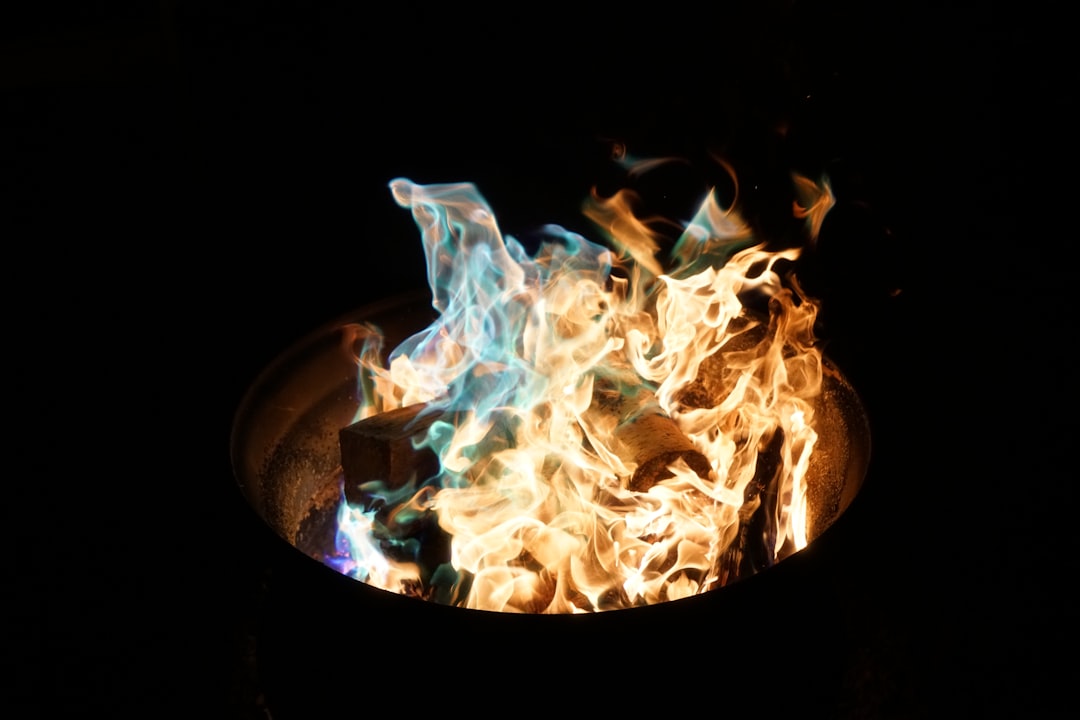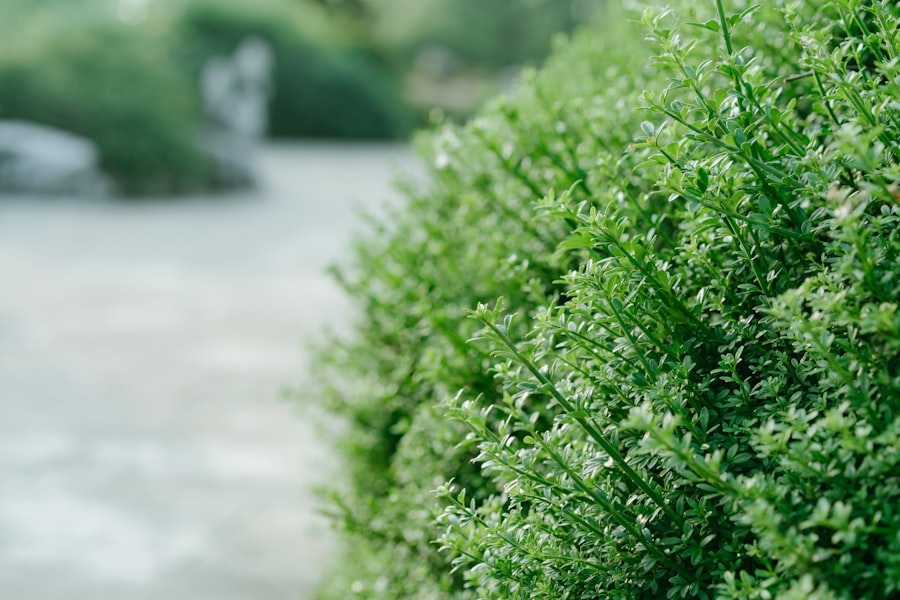Trimming Burning Bush: Timing is Key

Burning bush, also known as Euonymus alatus, is a popular shrub in landscaping due to its vibrant red foliage in the fall. It is native to Asia and was introduced to North America as an ornamental plant. Burning bush is known for its hardiness and ability to thrive in various soil conditions. However, like any other plant, it requires regular maintenance to ensure its health and appearance.
Trimming burning bush is essential for several reasons. Firstly, it helps maintain the desired shape and size of the shrub, preventing it from becoming overgrown and unruly. Trimming also promotes new growth and enhances the overall appearance of the plant. Additionally, regular trimming can prevent diseases by removing dead or diseased branches, allowing for better air circulation and sunlight penetration.
Key Takeaways
- Trimming burning bush is important for enhancing its appearance and health.
- The ideal time for trimming burning bush depends on factors such as weather and growth rate.
- Benefits of trimming burning bush include promoting new growth and preventing disease.
- Proper preparation for trimming burning bush includes using the right tools and safety measures.
- When trimming burning bush, it’s important to follow a step-by-step guide and avoid common mistakes.
The Ideal Time for Trimming Burning Bush: Factors to Consider
When deciding the ideal time for trimming burning bush, there are several factors to consider. One important factor is the specific variety of burning bush you have. Different varieties may have different growth patterns and may require trimming at different times of the year.
In general, the best time to trim burning bush is during late winter or early spring, before new growth begins. This allows the plant to recover quickly and promotes healthy growth throughout the growing season. However, if you have a variety that blooms in early spring, it is best to wait until after flowering to trim.
Another factor to consider is the climate in your region. If you live in an area with harsh winters, it may be best to wait until early spring to trim burning bush. This will protect the plant from potential frost damage that can occur if it is pruned too early.
Benefits of Trimming Burning Bush: Enhancing Its Appearance and Health
Trimming burning bush offers several benefits for its appearance and health. Firstly, regular trimming helps maintain the desired shape and size of the shrub. This is especially important for burning bush, as it has a tendency to become overgrown and unruly if left untrimmed. By trimming, you can keep the shrub compact and well-maintained.
Trimming also promotes new growth in burning bush. When you prune the branches, it stimulates the plant to produce new shoots and leaves. This can result in a fuller and more vibrant shrub. Additionally, trimming allows for better air circulation and sunlight penetration, which can help prevent diseases.
Furthermore, trimming burning bush can help remove dead or diseased branches. This is important for the overall health of the plant, as dead or diseased branches can attract pests and spread diseases to other parts of the shrub. By removing these branches, you can prevent further damage and promote the overall health of the burning bush.
How to Prepare for Trimming Burning Bush: Tools and Safety Measures
| Topic | Data/Metrics |
|---|---|
| Tools Required | Pruning shears, loppers, pruning saw, safety goggles, gloves, ladder |
| Frequency of Trimming | Every 2-3 years |
| Best Time to Trim | Late winter or early spring before new growth appears |
| Height to Trim | No more than one-third of the bush’s height |
| Safety Measures | Wear safety goggles and gloves, use a sturdy ladder, avoid trimming near power lines, and never trim during wet or windy conditions |
Before trimming burning bush, it is important to gather the necessary tools. The tools you will need include pruning shears, loppers, and a pruning saw. Pruning shears are ideal for cutting small branches up to 1/2 inch in diameter, while loppers are suitable for branches up to 2 inches in diameter. A pruning saw may be necessary for larger branches.
Safety measures should also be taken before and during trimming burning bush. It is important to wear protective gloves and safety glasses to protect your hands and eyes from potential injuries. Additionally, make sure to inspect the area around the burning bush for any hazards, such as uneven ground or obstacles that could cause accidents.
Step-by-Step Guide to Trimming Burning Bush: Techniques and Tips
To trim burning bush effectively, follow this step-by-step guide:
1. Start by inspecting the shrub and identifying any dead or diseased branches that need to be removed. These branches will typically be discolored, brittle, or have no new growth.
2. Use pruning shears or loppers to remove the dead or diseased branches. Make clean cuts just above a bud or lateral branch to promote new growth.
3. Next, trim any branches that are crossing or rubbing against each other. This will help prevent damage and allow for better air circulation.
4. To maintain the desired shape and size of the burning bush, selectively prune branches that are growing too long or out of place. Make cuts just above a bud or lateral branch to encourage new growth in the desired direction.
5. Step back periodically to assess the overall shape and balance of the shrub. Make additional cuts as needed to achieve the desired appearance.
6. Finally, clean up any debris and dispose of it properly. This will help prevent the spread of diseases and pests.
When trimming burning bush, it is important to avoid cutting too much at once. Removing more than one-third of the shrub’s branches can put stress on the plant and hinder its ability to recover. It is also important to make clean cuts just above a bud or lateral branch to promote new growth in the desired direction.
Common Mistakes to Avoid When Trimming Burning Bush

When trimming burning bush, there are several common mistakes to avoid. One common mistake is cutting too much at once. Removing more than one-third of the shrub’s branches can put stress on the plant and hinder its ability to recover. It is best to trim gradually over time, allowing the plant to adjust and recover between trimmings.
Another common mistake is making improper cuts. It is important to make clean cuts just above a bud or lateral branch to promote new growth in the desired direction. Avoid leaving stubs or cutting too close to the main stem, as this can lead to damage and disease.
Additionally, it is important to avoid trimming burning bush during periods of extreme heat or drought. This can put additional stress on the plant and hinder its ability to recover. It is best to trim during cooler periods or when the plant is well-hydrated.
How Often Should You Trim Your Burning Bush?
The frequency of trimming burning bush depends on several factors, including the specific variety, desired shape and size, and the overall health of the shrub. In general, burning bush should be trimmed once a year to maintain its shape and size. However, if you prefer a more compact shrub, it may need to be trimmed more frequently.
It is important to note that burning bush grows relatively slowly, so it does not require frequent trimming like some other shrubs. Over-trimming can actually hinder the plant’s ability to grow and recover. It is best to trim gradually over time, allowing the plant to adjust and recover between trimmings.
Signs that Indicate Your Burning Bush Needs Trimming
There are several signs that indicate your burning bush needs trimming. One sign is overgrown branches that are extending beyond the desired shape and size of the shrub. If the branches are obstructing walkways or blocking sunlight from reaching other plants, it may be time to trim.
Another sign is dead or diseased branches. These branches will typically be discolored, brittle, or have no new growth. Removing these branches will not only improve the appearance of the shrub but also promote its overall health.
Additionally, if you notice any branches that are crossing or rubbing against each other, it may be necessary to trim them. This will help prevent damage and allow for better air circulation.
Trimming Burning Bush in Different Seasons: Challenges and Solutions
Trimming burning bush in different seasons can present unique challenges. In late winter or early spring, when it is ideal to trim burning bush, the shrub may still be dormant. This can make it difficult to identify dead or diseased branches. To overcome this challenge, carefully inspect the shrub and look for any signs of discoloration or lack of new growth.
Trimming burning bush in the summer can also be challenging due to the heat and potential drought conditions. It is important to trim during cooler periods of the day and ensure that the plant is well-hydrated before trimming. This will help prevent additional stress on the plant and promote its ability to recover.
In the fall, when burning bush is known for its vibrant red foliage, it may be tempting to trim. However, it is best to wait until after the leaves have fallen to trim. This will allow the plant to fully transition into dormancy and prepare for winter.
Maintaining Your Burning Bush with Proper Trimming
In conclusion, trimming burning bush is essential for maintaining its health and appearance. By trimming regularly, you can promote new growth, prevent diseases, and maintain the desired shape and size of the shrub. It is important to consider factors such as the specific variety, climate, and overall health of the shrub when deciding the ideal time for trimming.
When trimming burning bush, it is important to gather the necessary tools and take safety measures to protect yourself and the plant. Following a step-by-step guide and avoiding common mistakes will help you achieve the desired shape and size of the shrub.
By maintaining your burning bush with proper trimming, you can enjoy a vibrant and healthy shrub in your landscaping for years to come.
If you’re wondering when to trim a burning bush, you may find this article on Lawn World’s website helpful. It provides valuable insights and tips on pruning and maintaining burning bushes in your garden. Check out their comprehensive sitemap to easily navigate through their wide range of informative articles on lawn care and landscaping: https://www.lawnworld.com/sitemap.html.
FAQs
What is a burning bush?
A burning bush is a deciduous shrub that is known for its bright red foliage in the fall.
Why do you need to trim a burning bush?
Trimming a burning bush helps to maintain its shape and size, promote healthy growth, and prevent it from becoming overgrown.
When is the best time to trim a burning bush?
The best time to trim a burning bush is in late winter or early spring before new growth begins.
How much should you trim a burning bush?
You should only trim up to one-third of the burning bush’s total height and width to avoid damaging the plant.
What tools do you need to trim a burning bush?
You will need pruning shears, loppers, and possibly a pruning saw to trim a burning bush.
Can you trim a burning bush in the summer?
It is not recommended to trim a burning bush in the summer as it can cause stress to the plant and make it more susceptible to disease and pests.
What should you do after trimming a burning bush?
After trimming a burning bush, you should remove any debris and dispose of it properly. You can also apply a slow-release fertilizer to promote healthy growth.



